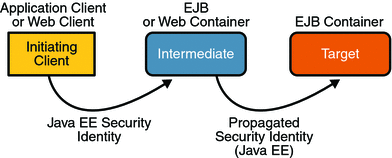Propagating Security Identity
You can specify whether a caller’s security identity should be used for the execution of specified methods of an enterprise bean, or whether a specific run-as identity should be used.
Figure 29–2 illustrates this concept.
Figure 29–2 Security Identity Propagation

In this illustration, an application client is making a call to an enterprise bean method in one EJB container. This enterprise bean method, in turn, makes a call to an enterprise bean method in another container. The security identity during the first call is the identity of the caller. The security identity during the second call can be any of the following options:
-
By default, the identity of the caller of the intermediate component is propagated to the target enterprise bean. This technique is used when the target container trusts the intermediate container.
-
A specific identity is propagated to the target enterprise bean. This technique is used when the target container expects access using a specific identity.
To propagate an identity to the target enterprise bean, configure a run-as identity for the bean as discussed in Configuring a Component’s Propagated Security Identity.
Establishing a run-as identity for an enterprise bean does not affect the identities of its callers, which are the identities tested for permission to access the methods of the enterprise bean. The run-as identity establishes the identity that the enterprise bean will use when it makes calls.
The run-as identity applies to the enterprise bean as a whole, including all the methods of the enterprise bean’s business interface, home interface, component interface, and web service endpoint interfaces, the message listener methods of a message-driven bean, the time-out callback method of an enterprise bean, and all internal methods of the bean that might be called in turn.
Configuring a Component’s Propagated Security Identity
You can configure an enterprise bean’s run-as, or propagated, security identity using either of the following:
-
The following example illustrates the definition of a run-as identity using annotations:
@RunAs("admin") @Stateless public class EmployeeServiceBean implements EmployeeService { ... } -
The role-name element of the run-as application deployment descriptor element (web.xml, ejb-jar.xml)
The following example illustrates the definition of a run-as identity using deployment descriptor elements:
... <enterprise-beans> ... <session> <ejb-name>EmployeeService</ejb-name> ... <security-identity> <run-as> <role-name>admin</role-name> </run-as> </security-identity> ... </session> ... </enterprise-beans> ...
Alternately, you can use the use-caller-identity element to indicate that you want to use the identity of the original caller, as shown in the code below:
<security-identity>
<use-caller-identity />
</security-identity>
You must explicitly specify the run-as role name mapping to a given principal in sun-web.xml or sun-ejb-jar.xml if the given roles associate to more than one user principal.
More detail about the elements contained in deployment descriptors is available in the Sun Java System Application Server 9.1 Application Deployment Guide.
In either case, you will have to map the run-as role name to a given principal defined on the Application Server if the given roles associate to more than one user principal. Mapping roles to principals is described in Mapping Security Roles to Application Server Groups.
Trust between Containers
When an enterprise bean is designed so that either the original caller identity or a designated identity is used to call a target bean, the target bean will receive the propagated identity only; it will not receive any authentication data.
There is no way for the target container to authenticate the propagated security identity. However, because the security identity is used in authorization checks (for example, method permissions or with the isCallerInRole() method), it is vitally important that the security identity be authentic. Because there is no authentication data available to authenticate the propagated identity, the target must trust that the calling container has propagated an authenticated security identity.
By default, the Application Server is configured to trust identities that are propagated from different containers. Therefore, there are no special steps that you need to take to set up a trust relationship.
- © 2010, Oracle Corporation and/or its affiliates
